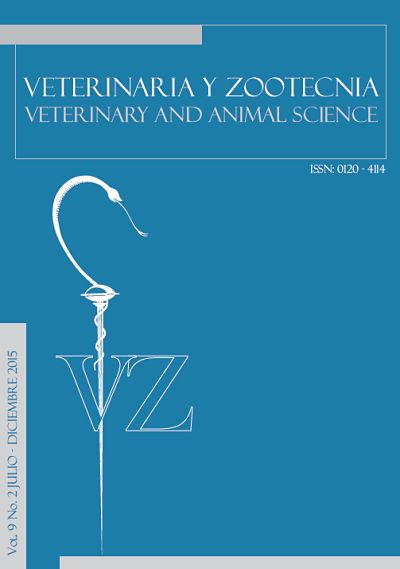Authors
Abstract
A 42-month-old Colombian Creole horse suffers a deep wound in the paracuneal sulcus of the frog on the left hind limb (LHL) causing an infection in the back of the hoof because of a screw perforation. At the clinical examination, the horse showed a claudication 5/5 of the LHL, member in clamp, decreased flight arc, increased temperature over the coronary band, positive digital pulse, bulb inflammation and presence of fester content. Prior to perfusion, field anesthesia protocol was performed: pre-medication with acepromazine (0.04 mg / Kg IM), and after 30 minutes a total intravenous anesthesia (TIVA) was administered with triple drip KXG (ketamine 1 g + xylazine 250 mg in 0.5 liter of 5% guaifenasin), administered at a rate of 2-3 ml / kg / h. A tourniquet was placed in the proximal part of the metatarsal. Distal to the tourniquet, prior disinfection and depilation, a 22-gauge butterfly catheter was fixed to the digital middle vein and 2 grams of amikacin diluted in 10 ml of 0.9% saline solution were administered. Regional intravenous infusion and bandage change were performed for 3 consecutive days using in these sessions an anesthetic protocol of ketamine (3 mg / kg IV) and xylazine (1 mg / kg IV) and the same amount of amikacin. The horse achieved full recovery and returned to training one month after the injury.
References
Boado, A. et al. Case report: Use of nuclear scintigraphy and magnetic resonance imaging to diagnose chronic penetrating wounds in the equine foot. Equine Veterinary Education, v. 17, n. 2, p. 62-68, 2005.
Boothe, D. et al. Pharmacokinetics and pharmacodynamics of enrofloxacin and a low dose of amikacin administered via regional intravenous limb perfusion in standing horses. AJVR, v. 67, n. 10, p. 1687-1695, 2006.
Borba, J. et al. Frog puncture wound with navicular bursa involvement in a horse – a Case report. Rev. Bras. Med. Vet, v. 38, n. 1, p. 65-68, 2016.
Butt, T.D. et al. Comparison of 2 techniques for regional antibiotic delivery to the equine forelimb: Intraosseous perfusion vs. intravenous perfusion. Can Vet J, v. 42, p. 617-622, 2001.
Cimetti, L. et al. How to Perform Intravenous Regional Limb Perfusion Using Amikacin and DMSO. En: 50th Annual Convention of the American Association of Equine Practitioners, 2004, Denver.
Dobareiner, R.M. et al. Trauma to the sole and wall. En: Dyson, S.J.; Ross, M.W. (Ed). Diagnosis and management of lameness in the horse. Philadelphia: Saunders, 2003. p. 275-282.
Finsterbusch, A.; Weinberg, H. Venous perfusion of the limb with antibiotics for osteomyelitis and other chronic infections. The Journal of Bone and Joint Surgery, v. 54, n. 6, p. 1227-1234, 1972.
Kilcoyne, I. et al. Penetrating injuries to the frog (cuneus ungulae) and collateral sulci of the foot in equids: 63 cases (1998-2008). J. Am Vet Med Assoc, v. 239, p. 1104-1109, 2011.
Levine, D.G. et al. Efficacy of Three Tourniquet Types for Intravenous Antimicrobial Regional Limb Perfusion in Standing Horses. Veterinary Surgery, v. 39, p. 1021-1024, 2010.
Murphey, E. et al. Regional intravenous perfusion of the distal limb of horses with amikacin sulfate. J. Vet. Pharmacol. Therap, v. 22, p. 68-71, 1999.
O’Grady, S.; Rich, W. Septic Diseases Associated with the Hoof Complex Abscesses, Punctures Wounds, and Infection of the Lateral Cartilage. Vet Clin Equine, v. 28, p.423-440, 2012.
Orsini, J. et al. Pharmacokinetics of amikacin in the horse following intravenous and intramuscular administration. J Vet Pharmacol Ther, v. 8, n. 2, p. 194-201, 1985.
Redding, W.R. Pathologic conditions involving the internal structures of the foot. En: Floyd, A.E.; Mansmann, R.A. (Ed). Equine podiatry. Missouri: Saunders, 2007. p. 273-278.
Richardson, G.L. et al. Puncture wounds of the navicular bursa in 38 horses a retrospective study. Veterinary Surgery, v. 15, n. 2, p. 156-160, 1986.
Smith, B. Medicina interna de grandes animales. Trastornos de los huesos, las articulaciones y el tejido conjuntivo. Barcelona: Elsevier, 2010. 1242p.
Wongaumnuaykul, S. et al. Doppler sonographic evaluation of the digital blood flow in horses with laminitis or septic pododermatitis. Veterinary Radiology & Ultrasound, v. 47, n. 2, p. 199-205, 2006.
Zhanel, G. Influence of pharmacokinetic and pharmacodynamic principles on antibiotic selection. Curr Infect Dis Rep, v. 3, p. 29-34, 2001.

 pdf (Español (España))
pdf (Español (España))
 FLIP
FLIP














